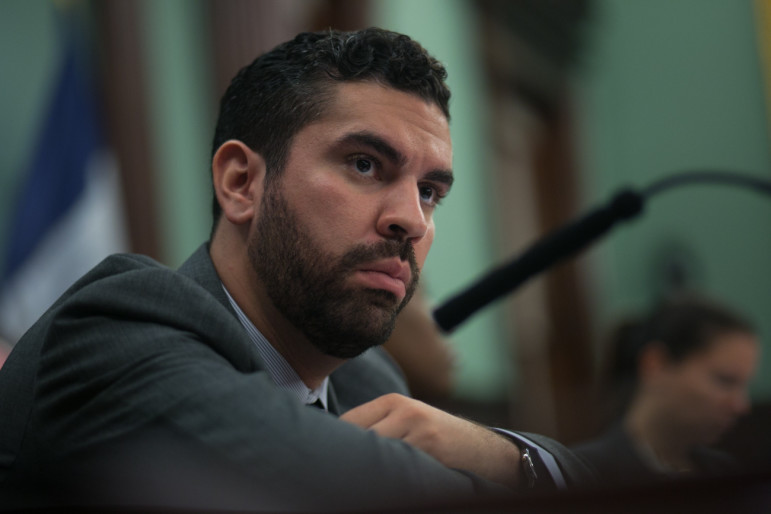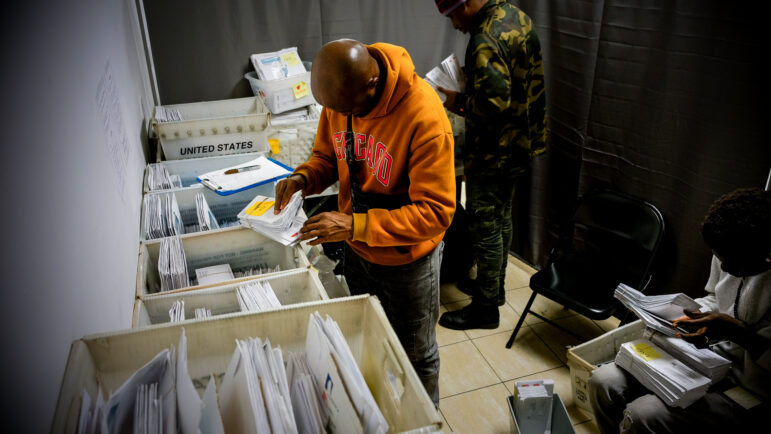
William Alatriste for the New York City Council
Councilman Rafael Espinal, who represents the bulk of the area that would be rezoned (file photo). He says there's 'a long way to go' to a deal on East New York.
At Monday’s City Council hearing on the De Blasio administration’s rezoning plan for East New York, the Council’s attitude mirrored its stance on Mandatory Inclusionary Housing: Something’s going to pass—but not without modifications to ensure the proposal meets the needs of low-income residents of color.
“To the administration, I want to let you know that though progress has been made since we started, I believe we have a long way to go,” said Council Member Rafael Espinal, who represents most of the area targeted for a rezoning. He laid out five topics that he said required more discussion: protections against displacement, depth of affordability in new housing, economic opportunities for neighborhood residents, matching infrastructure to the level of growth and ensuring the city keeps its commitments.
These five concerns dominated the discussion between members of the Subcommittee on Zoning and Franchises and the head administrators of the multiple city agencies driving the plan. Ultimately, the Council agreed to keep prodding, and the agencies to keep being prodded—but what that final compromise might look like is still hard to envision.
Preventing displacement
Perhaps heeding criticism that the administration has failed to place enough emphasis on the “preservation” portion of its affordable housing plan, Vicki Been, the Commissioner of the Department of Housing Preservation and Development (HPD), spoke first of the city’s anti-displacement efforts in East New York.
“Protecting residents who are vulnerable to displacement is our number one priority,” she said, reviewing HPD’s efforts to renew preservation agreements for regulated units and to bring some of the over 20,000 unregulated units in the neighborhood under a regulatory framework. Asked for an exact number of new units that HPD expects to bring under its programs, however, Been said it was too challenging to predict.
She emphasized that while HPD usually focuses on deals with large buildings, HPD is retooling itself to address the preservation of affordability in the one-to-two family buildings that dominate East New York. And in response to the demands of community members, HPD is working with the Center for NYC Neighborhoods to create a “Homeowner Helpdesk” in East New York that will provide counseling to homeowners struggling with foreclosure, scams and other issues.
Some Council members and community advocates are pressing for a more exhaustive strategy. Members of Cypress Hills Local Development Corporation (CHLDC) called on the Council to adopt the anti-displacement policies proposed by the Coalition for Community Advancement, which has put forward its own rezoning plan, and they asked for timetables for bringing units under new programs. Donovan said the Council must consider Councilmember Brad Lander’s bill to establish anti-harassment zones, which would require greater HPD oversight over landlords wishing to demolish or alter buildings.
Depth of affordability
Councilmembers grappled with the ambiguity of a crucial figure: the percentage of potential new units that would be designated affordable. The city’s Environmental Impact Statement estimates that the plan will lead to the creation of around 6,900 units of housing, and HPD has promised that in the first two years of the plan they will provide subsidies to generate 1,200 affordable units. The city has suggested that altogether, half the units created by the plan will be rented at below-market rates, but at the hearing they conceded this was an “estimate” dependent on market conditions.
If it takes many years for the East New York market to heat up—as city officials and testifying developers said it would—it’s more likely that a large percentage of units created by the rezoning would be affordable. Under East New York’s weak market conditions, the city’s market study indicates developers are only able to build with city subsidies. The lack of the 421-a tax credit may drive more developers to seek subsidy deals with the city, Been said. HPD is committed to providing subsidies only when developers commit to 100 percent affordability.
If the neighborhood’s market takes off faster than expected, however, it’s possible that much less than 50 percent will be affordable because developers will not need subsidies to turn a profit. In that case, the city’s proposed Mandatory Inclusionary Housing policy could ensure that 25 percent of the units created in those developments are reserved for families making an average of $46,620 (for a household of three)—but some community residents say that percentage and level of affordability would not meet the need of East New Yorkers, who on average make less than $33,000 a year. Both Espinal and Councilmember Inez Barron, who represents part of the rezoning area, are looking for more public and large private sites where developers will commit in advance to 100 percent affordability.
Barron, like many who offered testimony, pointed out the disjuncture between the depth of affordability provided by the plan and neighborhood incomes. Of the 1,200 units guaranteed by the city, only about a fourth will be for families making less than $31,080. On the other hand, land-use committee chairman David Greenfield commended the plan for its “historic levels of deep affordability” and a few affordable housing developers testified in support, warning that requiring deeper levels of affordability would require an unsustainable amount of subsidy from the city.
Economic development opportunities
While Been discussed the details of the zoning designations, dozens of protestors interrupted with an unexpected chant: “How Many More Must Die?”
The members of the Construction & General Building Laborers’ Local 79 called for safety standards for construction jobs. Councilmember Vanessa Gibson later took up the question, asking how the administration planned to ensure labor standards and a fair share of contracts for Minority and Women Owned Business (MWBEs) if the administration believed such provisions couldn’t be included in a zoning amendment. Been insisted there have been no deaths on HPD sights, that the agency can tailor RFPs to ensure local firms are hired, and that HPD has a stellar record of working with MWBE programs.
Instead of protests, Commissioner Gregg Bishop of the Department of Small Business Services (SBS) was greeted with “spirit fingers” or silent applause from nearly the entire audience. He said SBS is currently searching for a site for a Workforce1 center that will provide services tailored to the needs of the East New York Community and that SBS would be launching a FastTrac GrowthVenture course in both Spanish and English to help East New York business owners take advantage of the changing market. SBS is also developing a Commercial Needs Assessment of the neighborhood. In addition, the city has just updated its HIRE NYC program to require any developer receiving $2 million in HPD subsidies to post jobs at Workforce1. Councilmember Donovan Richards wants to lower that threshold to ensure more local hiring opportunities.
Maria Torres-Springer, president of the Economic Development Corporation (EDC), said EDC is finalizing a study of the needs of the neighborhood’s Industrial Business Zone, and have already launched several projects to spur its growth, including the renovation of a city-owned industrial building in the IBZ. Espinal is looking for commitments from the city to follow through with the recommendations of EDC’s study, and also asked EDC to consider starting a business incubator in East New York.
One complaint centered around the city’s proposed rezoning of manufacturing land outside of the Industrial Business Zone to a “Mixed Use” designation. Councilmember Antonio Reynoso lambasted the administration for failing to encourage industrial jobs outside of the IBZ—a charge the city did not deny.
“We do see this as a transitional district. It may not encourage a lot of new industrial use,” said Department of City Planning director Purnima Kapur.
Infrastructure and accountability
Council members Barron and Espinal raised concerns that the city had not committed to a sufficient amount of community facilities and infrastructure to accommodate an increased population. Barron referenced the Department of City Planning’s own Environmental Impact Statement, which lists multiple adverse impacts that the city plan leaves “unmitigated,” including a lack of sufficient child-care seats and school seats.
Department of City Planning Commissioner Carl Weisbrod explained that the city will work to ensure that some of new subsidized affordable housing buildings have community facilities, including day-care centers, on their ground floor. And he explained that a new school, to be built on the publically owned Dinsmore-Chestnut site, would provide the area with “all the needs for at least the next 10 years.” According to the Environmental Impact Statement, however, the rezoning would still trigger overcrowding in the adjacent Community School District 19 subdistrict 2.
Espinal wanted to know why the city did not want to adopt the Coalition for Community Advancement’s proposal for a Special Purpose District that would require each new development provide sufficient community facilities and infrastructure. Weisbrod said that wouldn’t be necessary: The city would be held accountable through its transparent use of the $1 billion Neighborhood Development Fund, a new fund dedicated to improvements in the 15 neighborhoods the city plans to rezone.
They repeatedly asked administrators to explain how much of the fund would be apportioned for East New York. Weisbrod said that they were unable to give an exact number, but that they were already using the fund for renovations to Atlantic Avenue, Highland Park and City Line Park, and that likely East New York would get more than other neighborhoods—the advantage of going first.
“We need to know how much is the extent of each rezoning—so there’s some transparency around that,” Richards said.









2 thoughts on “Council Sees 5 Sticking Points on De Blasio Rezoning Plan”
Pingback: Small Businesses are Also Worried About the East New York Rezoning | City Limits
Pingback: "Stopping Foreclosure Rescue Scams in Their Track" and other headlines from 2016 - Center for New York City Neighborhoods